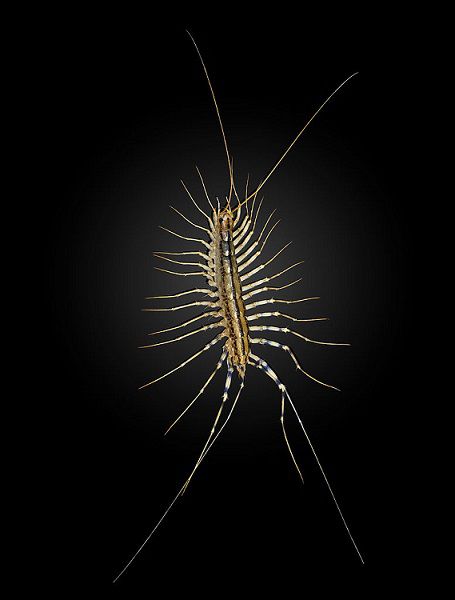Table of Contents
Like all other pets, centipedes require care and attention to ensure they remain healthy and content. If you are getting a centipede as a pet, you will need to ensure that, among other things, you have adequate housing and that you feed the appropriate food regularly.
Centipedes are interesting creatures and make for fascinating pets, but you should be aware from the very beginning that this is a pet to be observed rather than handled. In fact, centipedes can be very aggressive. Moreover, the bigger they are, the more dangerous and venomous they can be. You should avoid handling them as they can deliver a nasty bite. Furthermore, they are quite delicate, so rough handling could result in injury.
can be very aggressive. Moreover, the bigger they are, the more dangerous and venomous they can be. You should avoid handling them as they can deliver a nasty bite. Furthermore, they are quite delicate, so rough handling could result in injury.
If you are still keen to own a pet centipede, read on to find out more about what you will need.

Common Desert Centipede 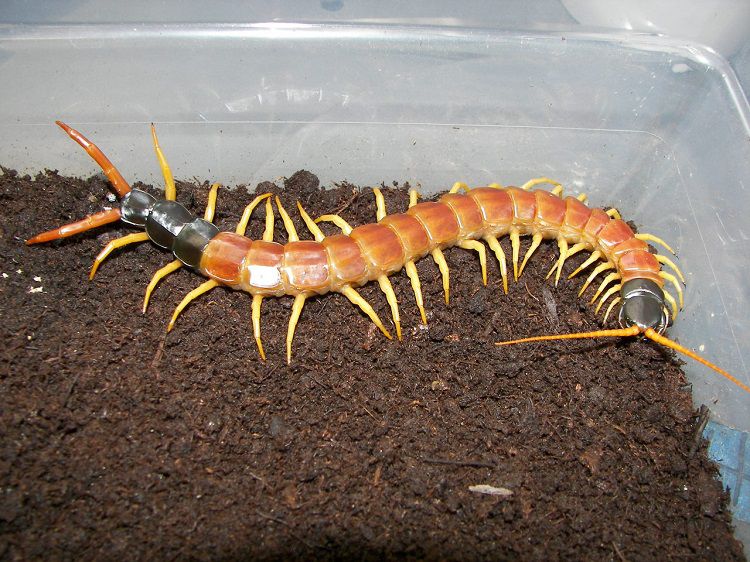
Giant Desert Centipede 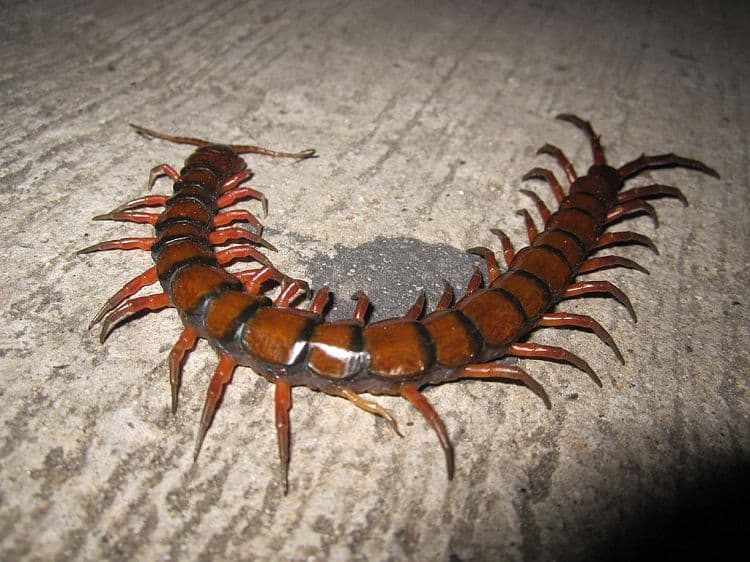
Amazonian Giant Centipede
Where to House Your Pet Centipede
Most owners keep their centipedes in a glass or plastic tank with a secure lid. However, it is important to find out what species of centipede you have and how big it is expected to grow as some can measure up to thirty centimeters long once fully mature. Having a centipede that is expected to grow quite large obviously means that you are going to need a large tank to allow it to move about freely.
A centipede’s tank should also be fairly deep with a substantial layer of substrate for burrowing. Good choices for substrate include peat moss, potting compost, or a mix of soil and compost. If you would prefer to be able to see your centipede more regularly, you can use a shallower substrate, although the creature will definitely prefer substrate that is quite deep.
You will need to ensure that the lid of the tank can be closed securely from outside as centipedes have an amazing ability to escape; and they are quite strong for their size, as well. You should also make sure that the lid on the tank is perforated to allow air in.
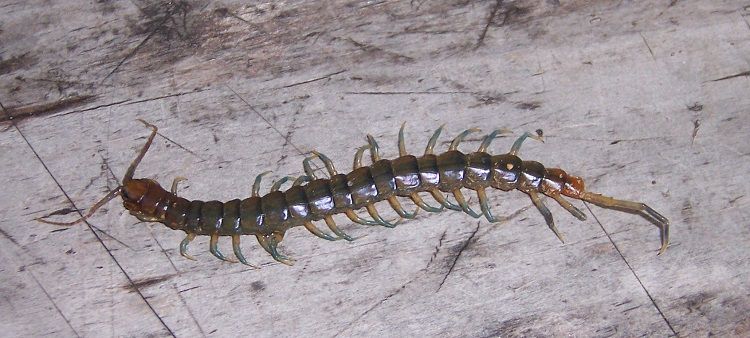
The Right Environment
Centipedes require a rather humid environment of approximately 75-85% humidity. They also prefer a temperature of around 80oF. You can keep the temperature stable by using heat pads or ceramic heaters. However, if using artificial heating, you must remember to regularly attend to the humidity of the enclosure to prevent it from drying out. You can do this by placing a dish of water inside the tank and also by spraying the substrate often to ensure it stays moist.
As centipedes are nocturnal creatures, you will not require artificial lighting for the tank. You should also make a point of keeping the enclosure out of direct sunlight. In the evening times, try to make sure that the cage is situated in a dimly lit area of your home. You could even buy a nocturnal light, which is a light that will not give out much light but one that will provide necessary heat.
Feeding Your Centipede
Centipedes require live food as they are carnivorous creatures. They like to eat regularly and prefer things such as crickets, cockroaches, mealworms, and silverfish. You should offer food at least twice every day and remove any uneaten food from previous feeds before providing new food. Although some centipedes are capable of eating food that is much larger than its own size, it is best to only offer food that is around half its size to prevent it being injured during the hunt.
as they are carnivorous creatures. They like to eat regularly and prefer things such as crickets, cockroaches, mealworms, and silverfish. You should offer food at least twice every day and remove any uneaten food from previous feeds before providing new food. Although some centipedes are capable of eating food that is much larger than its own size, it is best to only offer food that is around half its size to prevent it being injured during the hunt.
Note that when you feed your centipede, be sure to use forceps or long-handled tweezers to place food into the tank as the creatures can be very aggressive and could even bite you.
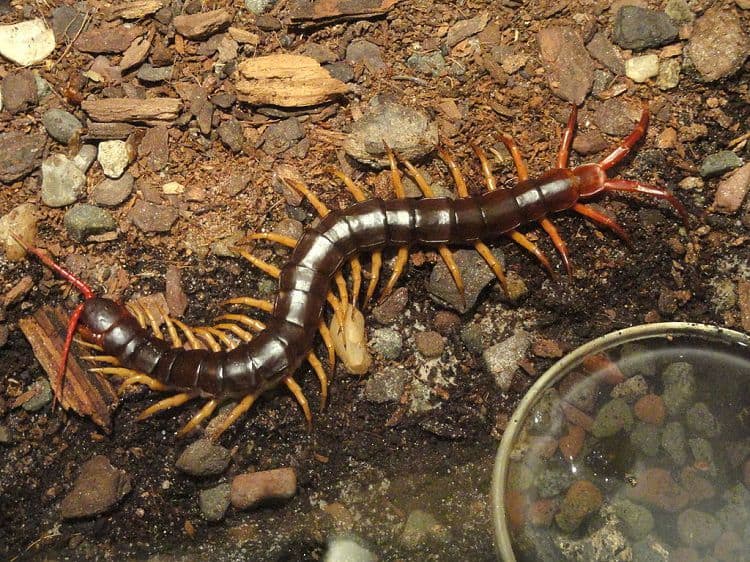
Chinese Red-Headed Centipede 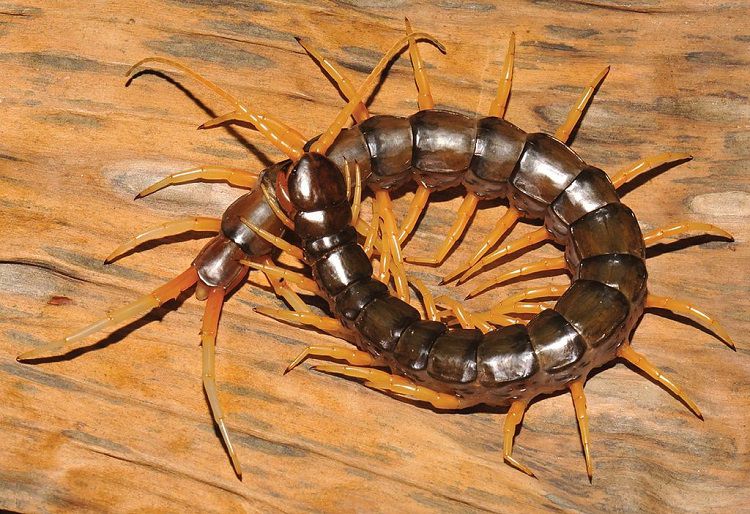
Waterfall Centipede
Handling Your Centipede
As mentioned above, centipedes are aggressive creatures and as such should not be handled unless absolutely necessary. Unlike many other exotic pets, you should be extremely cautious about handling a centipede as it will almost certainly bite. Moreover, depending on the size and species, this could end up being quite painful. There is also a risk of the centipede making you ill.
Although centipede venom is not fatal to humans, it could result in breathing difficulties, fever, and dizziness. There is also a risk of being allergic to the venom. If you really do have to handle your centipede, make sure you wear protective gloves and ensure your arms are also covered, either with the gloves or a long-sleeved top.
When handling a centipede, be incredibly careful as they are delicate creatures. They are also very quick, so you will need to have a firm grip but ensure you do not squeeze too hard. You need to control its movement while also being very gentle.
Photo Credits:
- Featured Image (House Centipede): This file is licensed under the Creative Commons
 Attribution-Share Alike 4.0 International
Attribution-Share Alike 4.0 International license.
license. - Waterfall Centipede: This file is licensed under the Creative Commons
 Attribution 3.0 Unported
Attribution 3.0 Unported license.
license. - Amazonian Giant Centipede: Katka Nemčoková
 – This file is licensed under the Creative Commons
– This file is licensed under the Creative Commons Attribution-Share Alike 3.0 Unported
Attribution-Share Alike 3.0 Unported license.
license. - Giant Desert Centipede: John
 – This file is licensed under the Creative Commons
– This file is licensed under the Creative Commons Attribution 2.0 Generic
Attribution 2.0 Generic license.
license. - Red-Headed Centipede: B. Navez – This file is licensed under the Creative Commons
 Attribution-Share Alike 3.0 Unported
Attribution-Share Alike 3.0 Unported license.
license. - Common Desert Centipede: Matt Reinbold
 – This file is licensed under the Creative Commons
– This file is licensed under the Creative Commons Attribution 2.0 Generic
Attribution 2.0 Generic license.
license. - Chinese Red-Headed Centipede: Daderot
 – This file is made available under the Creative Commons
– This file is made available under the Creative Commons CC0 1.0 Universal Public Domain Dedication
CC0 1.0 Universal Public Domain Dedication .
.

